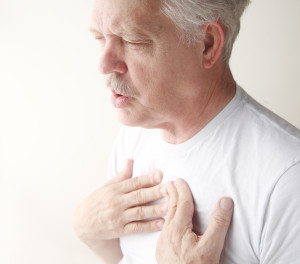Pulmonary hypertension can develop from disease process intrinsic to the pulmonary arteries (Group I disease or PAH), or from diseases of the left side of the heart (Group II Pulmonary Hypertension), or from lung tissue disease processes (Group III Pulmonary Hypertension). This page will focus on pulmonary hypertension caused by lung parenchyma (lung tissue) diseases.
Idiopathic Pulmonary Fibrosis and Pulmonary Hypertension
 The two most common lung diseases that lead to elevated pulmonary artery pressures are COPD (emphysema or chronic bronchitis) and Idiopathic Pulmonary Fibrosis (IPF). With progressive lung tissue disease, there is gradual loss of blood vessels, chronic low oxygen levels and a gradual increase in the pulmonary artery pressure. Over time, the higher pulmonary artery pressures result in the right side of the heart working harder and harder to pump blood through the pulmonary arteries. Eventually, the right side of the heart begins to dilate (enlarge) and patients begin to retain fluid (this is the beginning of right heart failure). At this time, patients notice leg swelling and perhaps abdominal swelling. Without treatment, this is a progressive decline. However, IPF treatments can improve symptoms and improve exercise capacity.
The two most common lung diseases that lead to elevated pulmonary artery pressures are COPD (emphysema or chronic bronchitis) and Idiopathic Pulmonary Fibrosis (IPF). With progressive lung tissue disease, there is gradual loss of blood vessels, chronic low oxygen levels and a gradual increase in the pulmonary artery pressure. Over time, the higher pulmonary artery pressures result in the right side of the heart working harder and harder to pump blood through the pulmonary arteries. Eventually, the right side of the heart begins to dilate (enlarge) and patients begin to retain fluid (this is the beginning of right heart failure). At this time, patients notice leg swelling and perhaps abdominal swelling. Without treatment, this is a progressive decline. However, IPF treatments can improve symptoms and improve exercise capacity.
COPD and Pulmonary Hypertension
COPD is one of the most common adult lung diseases. The vast majority of patients smoked cigarettes for more than 10 years. Occasionally, a patient may have COPD from chronic exposure to very poor air quality such as in a factory or related to a rare genetic disease called alpha-1 anti-trypsin deficiency. Symptoms begin slowly with cough, sputum, wheeze and progressive exercise intolerance. The disease is diagnosed by pulmonary function testing. High resolution CT scanning of the chest can diagnose emphysema as well. Treatments focus on inhaled medications that improve air flow through the airways. Smoking cessation is paramount.
Mild pulmonary hypertension is common in COPD but severe pulmonary hypertension is quite uncommon. The echocardiogram is particularly poor at estimating pulmonary artery pressures in patients with lung disease and right heart catheterization is required. Patients with mild elevations in pulmonary artery pressure do not require specific treatments targeting pulmonary hypertension. Diuretics are often used to treat fluid retention. Oxygen and inhaled medications are used to maximally treat low oxygen levels and airflow obstruction. Occasionally a patient will have very severe pulmonary hypertension associated with COPD. In these situations we will carefully embark on a treatment course with PAH medications. We avoid endothelin receptor antagonists as they have been found not to be beneficial. There is some limited data that PDE 5 inhibitors may be helpful. Some patients that are treated with pulmonary hypertension medications will paradoxically do worse due to worsening oxygen levels.
